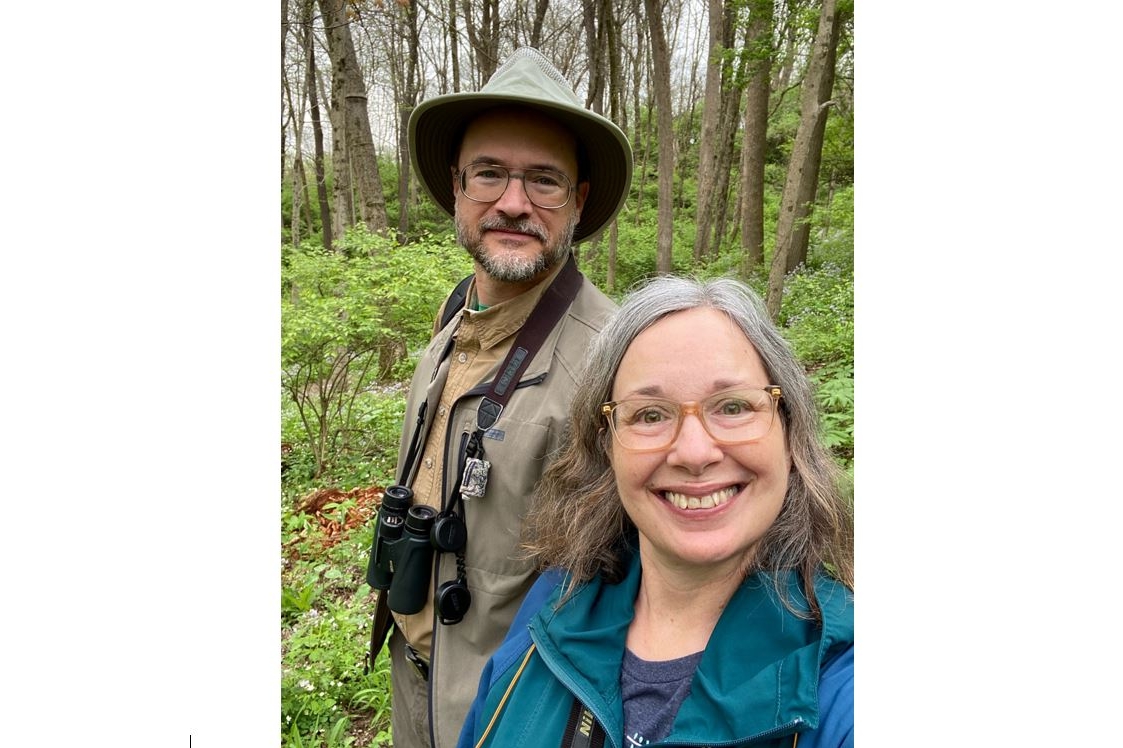Birding Johnson County
by Stephen & Susan Nawrocki
We have lived and birded in Johnson County since the early 1990s. Although we love our local birding outings, much of Johnson County is not particularly conducive to diverse birdlife. As a bedroom community for Indianapolis, most areas are either paved (commercial, industrial, or residential) or devoted to agriculture (corn & beans). Gravel mines lie along the White River in the northwestern portion of the county, adjacent to the currently-under-construction I-69. All but the extreme southernmost portion of the county lies squarely in the Tipton till plain, being flat and lacking interesting land features. The few lakes are typically small and/or artificial. Therefore, one should not expect to have the same kind of birding experience as might be obtained in, say, the Lake Michigan boundary counties, or in the western corridor with extensive prairie-marshland habitats (Jasper-Pulaski, Goose Pond, etc.).
Nevertheless, our birding in Johnson County has been reasonably successful with a little work. A casual county “Big Year” in 2019 produced ~150 species, and our total county list currently stands at about ~170 species. If you are new to the area or to birding, here are the places we would recommend.
Atterbury Fish & Wildlife Area
The DNR and Johnson County Parks manage this nearly 5000-acre parkland, located at the southeast corner of the county. Camp Atterbury is a large adjoining area and much of it is located in Bartholomew County. It is managed by the Indiana National Guard and is normally off-limits to the public. Access has been granted in the past for Christmas Bird Counts. Atterbury is dominated by grass and scrub/shrub habitat, much of which is successioning into young forest. More mature forest is largely restricted to a narrow strip along the west portion of the park and a larger area in the east between Mauxferry Road and Sugar Creek. A number of small lakes, ponds, and wetlands dot the FWA, creating an interesting patchwork of habitats. One of these, Teal Marsh, was drained this year. Recreation areas, run by Johnson County Parks, include a horse park, disk golf course, campground, model airfield, and a large-gauge model train pike, all of which occupy the central portion of the park. A few miles to the southeast of Atterbury, along SR 31, is Driftwood State Fishing Area, which has a large central lake that has attracted good winter waterfowl in the past. Much of the lake lies outside of Johnson County.
Birding Atterbury has evolved considerably over the past three decades. Military activities, cultivation, restoration projects, and management policies have shifted and changed. Historical documentation indicates that bird diversity at Atterbury has declined significantly since the 1970s and 1980s. Some shorebirds, grassland, and upland game species, such as Upland Sandpiper, Sedge Wren, and Ruffed Grouse, have completely disappeared. During the 2010s, Henslow’s Sparrow, Bell’s Vireo, and Yellow-breasted Chat seemed to be making a comeback in a number of pockets of the park. Still, in the past few years, we have had difficulty locating even single examples of these birds. However, there is still plenty to keep a birder busy in the park, and it occasionally pulls a card from up its metaphorical sleeve. For example, this past year a young scissor-tailed flycatcher hung out along Hospital Road for a week or two.
Since much of the park is easily accessible by car, the easiest way to familiarize yourself with the various habitats and hot spots is to download a map of the FWA and drive down every road. In particular, check out the following locations in spring and summer:
- The large grassy field immediately east of the southern extent of Stone Arch Road for Grasshopper Sparrow, Bobolink, Blue Grosbeak
- Stone Arch Lake for Purple Martin, various swallows species, and Belted Kingfisher
- The tiny bridge crossing the north extent of Teal Marsh on CR 650N for oriole species and Willow Flycatcher
- Coyote Marsh north of 650N for Sora and occasional holdover Ring-necked Pheasants from release-and-hunt programs
- Honker Haven pond at the north end of School House Road on the west side for heron species, dabbling ducks, and cuckoo species
- Along East North Street for Prairie Warbler, Eastern Towhee, and migrating warblers & sparrows
- The prairie restoration plot on the south end of School House Road on the east side, just north of Hospital Road for Eastern Bluebird, Northern Flicker, Eastern Meadowlark, and Bell’s Vireo
In the winter, the area between Coyote Marsh and Honker Haven is off-limits to protect breeding ducks. One can use a scope from the road or main path. During migration, random shorebirds can be found in flooded fields, along the north shore of the small pond immediately west of the horse park, and in the farmer’s fields immediately north of CR 550S.
Blue Heron Park, Franklin
This relatively new park runs along Youngs Creek south of Franklin. Mature woodland flanks the creek and has become a great spot for migrating passerines. A footbridge crosses the creek to the north and leads to a small pond and marsh, where we’ve had nesting Green Herons, Yellow Warblers, and Willow Flycatchers. A plot of prairie grassland lies at the far east end of the park. It is a bit of a hike from the parking lot. Watch out for disk golfers working their way through the woods!
Northwest Park, Greenwood
This park and its annex lie on the north side of Fry Road, west of SR 31. Bordering Pleasant Run Creek, like the larger Blue Heron Park, it includes a mix of mature riparian forest and more open fields. While this green corridor is compressed between commercial and residential areas, we have enjoyed walking the path between the two portions of the park and were quite pleased with the number of migrant passerines we saw. During the summer, orioles, tanagers, Wood Thrush, and Northern Parulas can be found.
Maple Grove Elementary School
Located just south of West Whiteland Road in about the center of the county, this school has become a magnet for migrating shorebirds. A large sloping cornfield drains north towards the school and into a large seasonal marshy basin. Spring rains fill the basin and can create some good mudflats. In each of the last three years, a large flock of Pectoral Sandpipers has taken up temporary residence on the grassy fields around the mudflats. Wilson’s Snipe, Greater Yellowlegs, Lesser Yellowlegs, Semipalmated Plover, and Black-bellied Plover have also visited.
Winter and Spring Strategy
A final strategy has worked well for us during the winter and spring. We drive the roads in the more rural northeast and southwest portions of the county, looking in small drainage ponds and flooded fields for waterfowl, shorebirds, and raptors. While bird densities are typically low, with patience one can tick off most of the more common residents and migrants.
Stephen is a Professor of Biology and comparative anatomist at the University of Indianapolis, while Susan is a plant biologist by training and is currently working as a Teacher’s Assistant in the Center Grove School System. Both are Indiana Master Naturalists, volunteer regularly at the Eagle Creek Park Ornithology Center, and have participated as a family in the ABAS Birdathon since 2006.
Photo of Stephen and Susan Nawrocki

